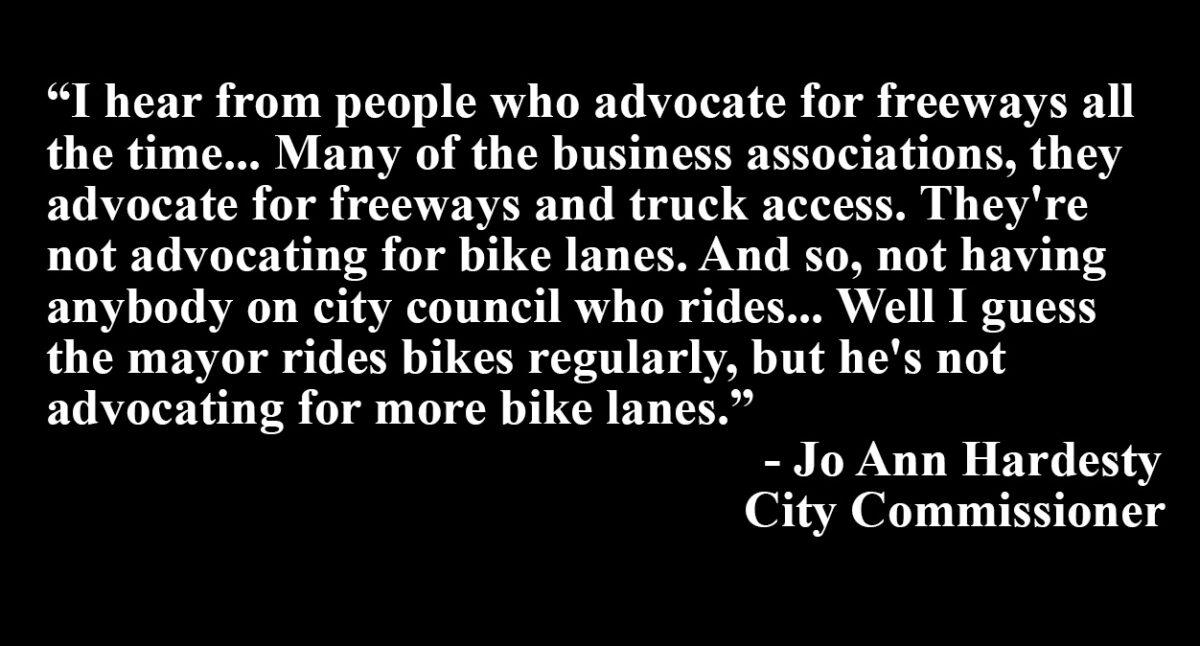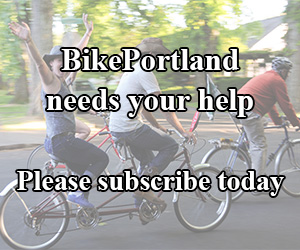Cycling News & Blog Articles
PBOT Commissioner has revealing, heated exchanges with bicycle advisory committee members

At her first visit to the Portland Bureau of Transportation Bicycle Advisory Committee Tuesday Night, Commissioner Jo Ann Hardesty was asked about Portland’s vaunted Bicycle Plan for 2030. She said she’d never heard of it and that PBOT leadership hadn’t mentioned it to her yet. She also said, “I don’t think that’s going to happen,” when asked about progress toward meeting the plan’s signature goal of 25% cycling mode share.
It was one of just several surprising exchanges at the meeting. All of which left many seasoned bike advocates deflated and disheartened.
“That was the most depressing and frustrating transportation meetings I’ve ever been in,” said one person via text after the meeting. “I feel embarrassed for PBOT on a regular basis,” said another. “But this was the worst.”
The question about the bike plan came from BAC member Catie Gould, who’s also a leader with Bike Loud PDX, a nonprofit that has worked to raise awareness of the plan. She wanted to know if Hardesty had anything to share about an overdue 10-year update to the plan. “It’s very, very far behind schedule,” Gould said. “I’m wondering if you’re aware of it.”
“I’ve heard nothing about the bike plan or about an update to it,” Hardesty replied. “Who actually produces that bike plan? Is it the Bureau of Planning and Sustainability?” Hardesty asked, as jaws dropped to desks.
“It’s PBOT,” Gould replied.
Hardesty: “It’s PBOT? Oh. I haven’t heard anything about it yet.”
Advertisement
Gould: “It was supposed to transform Portland into a world class biking city by 2030.”
Hardesty: “By 2035?”
Gould: “No. 2030. So, coming right up.”
Hardesty: “I don’t think that’s going to happen in that short time period, but I think we could get closer to that vision. If that is still the vision that we have.”
“Okay, well, thanks,” Gould replied, a bit stunned by what she’d heard. “I feel like if it does not get a public hearing or any education within city hall soon, it really will die.”
It’s clear no one within the PBOT leadership team (or elsewhere) felt the need to brief Hardesty on the bike plan, a plan that was intended to be a pillar of our transportation system when it passed 11 years ago.
And that was only one of the interesting exchanges last night.
BAC Chair David Stein asked Hardesty: “Is biking equitable? And if not, how do we make it so?”
Hardesty rightly explained that in her 32 years as a Portlander, bike lane projects have often been harbingers of gentrification. “Once the bike lanes came in, the community did radically change, and I think that’s a reality that, as a biking community, we haven’t dealt with.”
“Now east Portland is the place where people are like, ‘We need more bike lanes! We need more bike lanes!’,” Hardesty continued. “Well east Portland is also where people are being killed by automobiles on a regular basis, so my priority is slowing down cars and getting [fixed speed and red light] cameras out. My priority can’t be bike lanes when people are dying on the streets because cars are going too fast.”
“I think depending on who you are and what part of the city you’ve lived in, you’ve had different experiences with bike lanes, and the power that comes behind the people who have the power to demand bike lanes.”
A recurring theme in Hardesty’s comments was that if cycling advocates (a.k.a. “members of the cycling community”) want faster progress, they need to work harder to get people on bikes, change cultural perceptions, improve safety outcomes, lobby for projects, and so on.
“Let me challenge you a little bit,” she said in response to one BAC member’s question. “I think you could be really helpful in making biking more enticing for communities that are unaccustomed to riding bikes in Portland.” Hardesty explained how many people of color feel unsafe using our streets outside of a car. “If you can’t get in the crosswalk without feeling like you’re taking your life into your own hands, why would you put yourself on a bike and put yourself in more danger? So I challenge you, help us make it safer.”
Then Hardesty added, “Check people who think that riding a bike gives them special powers and special privileges. Help support lower-income folks getting bikes and learning how to use bikes.”
This led to an exchange about influence and lobbying at City Hall.
Advertisement
BAC Chair Stein said he the idea of a monolithic “bicycling community” is flawed. “It seems like a bit of a misnomer because I don’t necessarily consider myself part of a bicycling community. The same way that I drive, but I don’t think of myself as part of the driving community and I don’t feel like I need to advocate for driving.”
Stein then asked Hardesty why it is such a major (and usually losing) battle to get bike lanes on main commercial streets. “What does it take to make that the default rather than something that requires a massive political lift? You said yourself that our bike plan won’t happen by 2030 — well it’s not going to happen by 2040 or 2050 either if we’re putting all the pressure on a small group of people to outweigh the status quo.”
“If you feel so strongly about bike lanes,” Hardesty replied. “and your voice is not included in the deliberations, then that’s a voice that’s not included in the deliberations.”
“I hear from people who advocate for freeways all the time,” she continued. “They don’t have any problem advocating for being a driver and for more freeways. Many of the business associations, they advocate for freeways and truck access. They’re not advocating for bike lanes. And so, not having anybody on city council who rides… Well I guess the mayor rides bikes regularly, but he’s not advocating for more bike lanes.”
Then things got a bit heated between the commissioner and BAC member Clint Culpepper.
“I want to push back on a couple of things that you said,” Culpepper began. “I think there’s a real misconception about who advocates for bikes and some mythical ‘bicycle community’. And I think we forget that the majority of bicycle riders folks that use bicycles for transportation in the city are making less money than everybody else in the city. The reason you hear from folks about freeways is because those folks have time, they have time to bug you. They have business associations that have money that are doing that work.”
Hardesty questioned Culpepper’s point about low-income riders. “I don’t know if we have data that proves that people who ride bikes make less money.”
“We do,” Culpepper quickly responded (and he’s right, Census data clear shows the lower income a household has, the more likely the are to ride bikes).
“In East Portland we have more folks riding bicycles than we do in other places,” Culpepper continued. “The census data bears this out. The difference is, you don’t hear from those folks. You don’t hear from folks that are washing dishes and riding their bike home at two o’clock in the morning. We barely see those folks.”
Then Culpepper, in an impassioned plea, said he rejects the idea that an elected official and government agency leader is telling volunteer advocates they need to do more if they want safer streets and more access to them.
Advertisement
“Everybody in this room is a volunteer… This is what I am doing instead [of being with my family] because this is important. Why is this important? So that my children have a safe place to ride their bicycles and walk. I have one thing that I worry about every single day: That my two small children are going to get hurt or killed on our roads. And I think that PBOT’s continued prioritization of building more room for automobiles is appalling. Pedestrian safety is the number one issue in the city and every single person in this room feels that it is being shortchanged at every opportunity. We have to fight for scraps out there, because PBOT has refused to prioritize safety first and foremost.*” (*The 2021-2022 PBOT budget includes $6.8 million for Active Transportation & Safety and $188 million for Asset Management (paving, parking garage upkeep, signals and sign maintenance, and so on).)
“I hear your frustration Clint, but I certainly don’t agree with that,” Hardesty responded.
“Then why do we continue to have pedestrians die on our streets!?” Culpepper interjected loudly.
“Because we are trying to address a lack of infrastructure improvements that have been there since annexation [a reference to east Portland which was annexed into the city in the 1980s].”
“People aren’t just dying in east Portland, they are dying in north Portland, they are dying in northeast Portland they are dying in southeast Portland, they are dying in every part of this city! Regardless of when it was annexed, we have continued to pour money into the streets to make it easier for people to drive in this city, instead of prioritizing people’s safety!” Culpepper replied.
“Again,” Hardesty said. “I have to agree to disagree with you until I’ve seen some of the data that you are referring to.”
“160 people have died since 2019!” Culpepper said, becoming more animated. “It’s there. We know it’s there. I know this isn’t a lack of data. This is a lack of priorities within the bureau.”
Hardesty disagreed again. “I don’t know that it’s a lack of priorities, and because people are dying does not mean that the bureau is not prioritizing safety. It means that it can only do so much with the budget that it has… Have we done enough? We don’t have enough resources to do enough.”
Culpepper pushed back again, saying it’s a matter of priorities, not funding.
“Every single person in this city is a pedestrian in some form, right. Every single person. So why is it that that is not the number one priority?! We need safe crossings, we need rapid flashing beacons, we need actual functioning crosswalks, we need medians, we need every single road, every single lane in our city to be narrowed to reduce the speed!”
The exchange ended Culpepper and Hardesty in sharp disagreement about whether or not the Hawthorne Pave & Paint project will result in safer conditions for pedestrians (Culpepper thinks the wider lanes prove his point that PBOT prioritizes motorized vehicles over people, Hardesty says the project will have major safety benefits for people on foot).
After the dust settled a bit, Hardesty broke the tension: “It got a little hot in here,” she said, smiling. “But it’s OK. I can handle it.”
— Jonathan Maus: (503) 706-8804, @jonathan_maus on Twitter and This email address is being protected from spambots. You need JavaScript enabled to view it.
— Get our headlines delivered to your inbox.
— Support this independent community media outlet with a one-time contribution or monthly subscription.


